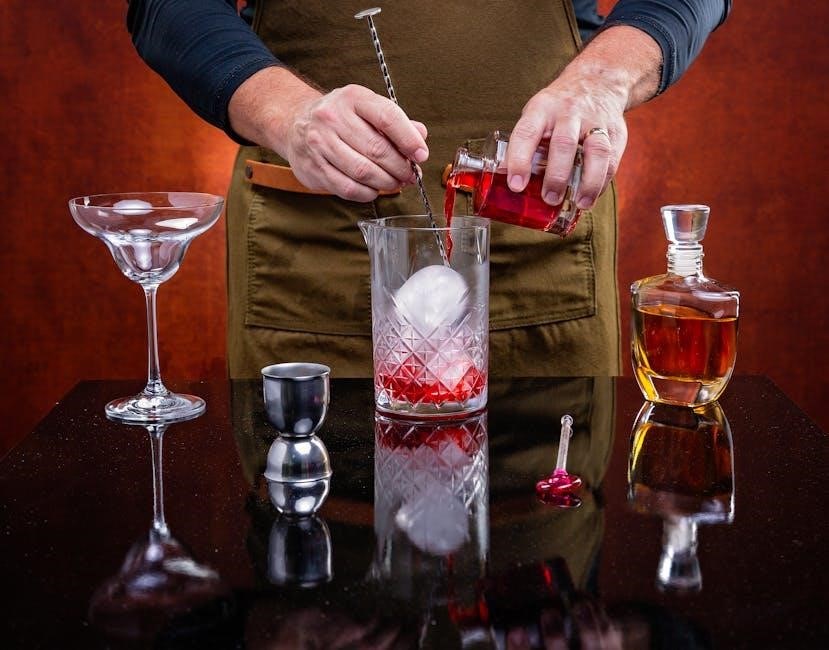bartender training manual pdf
This comprehensive Bartender Training Manual serves as a detailed guide for mastering essential bartending skills‚ drink preparation‚ and customer service. Designed for both newcomers and experienced professionals‚ it provides a structured approach to learning the art of mixology‚ ensuring consistency and excellence in every serve. The manual covers foundational knowledge‚ advanced techniques‚ and practical tools to elevate your bartending career‚ making it an indispensable resource for anyone in the hospitality industry.
Overview of the Bartender Training Manual
This Bartender Training Manual is a valuable resource designed to equip bartenders with the knowledge and skills needed to excel in the hospitality industry. It covers essential topics such as drink preparation‚ customer service‚ and bar operations‚ providing a comprehensive guide for both newcomers and experienced professionals. The manual includes detailed sections on spirits‚ wines‚ and mixers‚ as well as classic and modern cocktail recipes. Practical tools like checklists and templates are also provided to ensure efficiency and consistency. Whether you’re managing a bar or training new staff‚ this manual offers customizable content to suit your establishment’s needs. It emphasizes legal compliance‚ safety‚ and hygiene‚ ensuring a well-rounded understanding of bartending. By following this guide‚ bartenders can enhance their skills and contribute to a positive customer experience.
Importance of Bartender Training
Bartender training is essential for ensuring consistency‚ quality‚ and safety in bar operations. A well-trained bartender not only prepares drinks accurately but also enhances customer satisfaction through exceptional service. Proper training fosters a deep understanding of spirits‚ wines‚ and mixers‚ enabling bartenders to create memorable experiences. It also equips them with the skills to handle difficult situations and maintain a clean‚ hygienic environment. By investing in bartender training‚ establishments can build a knowledgeable and efficient team‚ leading to increased customer loyalty and higher profits. Effective training programs ensure compliance with legal standards and promote a culture of continuous improvement‚ making bartenders indispensable assets to any hospitality business. This foundation is crucial for both individual growth and the success of the establishment.
Structure and Content of the Manual
This Bartender Training Manual is organized into clear sections‚ each focusing on specific aspects of bartending. It begins with foundational skills and knowledge‚ such as understanding spirits‚ wines‚ and mixers‚ followed by detailed cocktail recipes and preparation techniques. The manual also covers essential topics like product pairing‚ customer service‚ and bar operations‚ including inventory management and safety protocols. Advanced sections delve into modern and signature drinks‚ presentation techniques‚ and legal compliance. Additional resources‚ such as checklists and a glossary‚ provide practical support. The manual is designed to be comprehensive yet easy to follow‚ ensuring bartenders gain the skills and confidence needed to excel in their roles. Its structured approach makes it a valuable tool for both training and ongoing professional development.
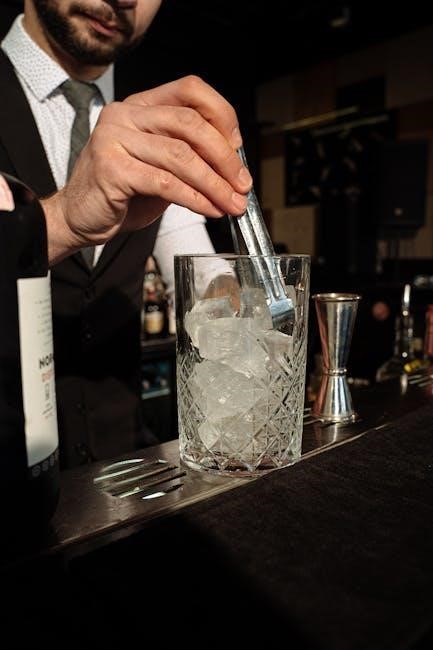
Essential Skills and Knowledge for Bartenders
Bartenders need foundational knowledge of spirits‚ wines‚ and mixers‚ along with skills in mixing techniques‚ drink presentation‚ and product pairing to deliver exceptional service and consistency.
Understanding Spirits‚ Wines‚ and Mixers
Understanding spirits‚ wines‚ and mixers is fundamental for bartenders to craft balanced and flavorful cocktails. Spirits include whiskey‚ rum‚ vodka‚ and gin‚ each with unique origins and flavor profiles. Wines‚ such as red‚ white‚ and sparkling‚ are used in specific cocktail recipes or as standalone drinks. Mixers like tonic water‚ soda‚ and juices enhance flavors and add depth to beverages. Knowledge of these ingredients allows bartenders to create classic and modern cocktails‚ pair drinks with food‚ and make informed recommendations to customers. This section provides detailed insights into the characteristics‚ uses‚ and combinations of spirits‚ wines‚ and mixers‚ ensuring bartenders can elevate their drink preparation and customer satisfaction.
Basic and Advanced Cocktail Recipes
Mastery of cocktail recipes is essential for any bartender‚ from classic drinks like the Old Fashioned and Margarita to modern creations. Basic recipes lay the groundwork‚ teaching fundamental techniques and ingredient ratios. Advanced recipes introduce complexity‚ incorporating unique spirits‚ house-made infusions‚ and innovative methods like molecular mixology. This section provides step-by-step guides‚ ingredient lists‚ and tips for perfecting both categories. It also explores variations and substitutions to accommodate preferences and dietary restrictions. By learning these recipes‚ bartenders can expand their creativity‚ enhance drink presentation‚ and deliver exceptional flavor profiles. This comprehensive guide ensures bartenders are well-equipped to craft memorable beverages for any occasion‚ whether it’s a simple sipper or an intricate signature cocktail.
Drink Preparation Techniques
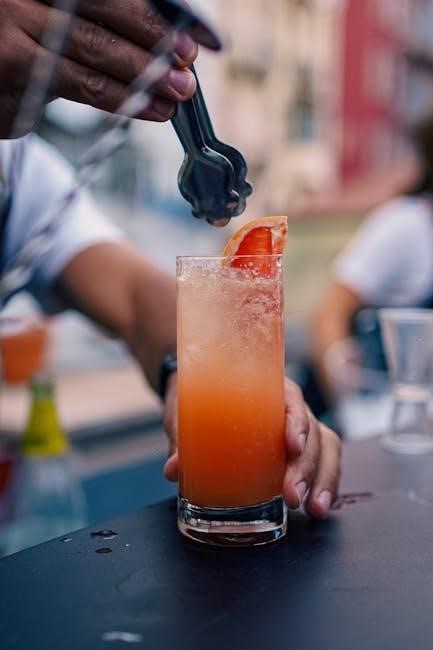
Mastery of drink preparation techniques is fundamental for every bartender. This section covers essential methods such as shaking‚ stirring‚ muddling‚ and straining‚ ensuring consistency and quality in every drink. Proper use of tools like shakers‚ jiggers‚ and muddlers is emphasized to achieve precise measurements and flavor balance. Techniques for layering‚ garnishing‚ and presenting drinks are also explored‚ enhancing the visual appeal of cocktails. Additionally‚ tips for handling ingredients‚ managing ice‚ and maintaining cleanliness are provided to streamline the preparation process. By mastering these techniques‚ bartenders can efficiently craft a wide range of beverages‚ from classic cocktails to modern creations‚ while maintaining professionalism and attention to detail behind the bar.
Product Knowledge and Pairing
Understanding spirits‚ wines‚ beers‚ and mixers is crucial for crafting exceptional cocktails. This section delves into the origins‚ flavor profiles‚ and pairing possibilities of various beverages‚ enabling bartenders to make informed decisions. By mastering product knowledge‚ bartenders can confidently recommend drinks‚ create harmonious flavor combinations‚ and enhance the dining experience. Learning how to pair cocktails with food or other beverages is also explored‚ offering a deeper understanding of complementary tastes. This knowledge not only elevates the quality of service but also helps in upselling and personalizing customer experiences‚ ensuring satisfaction and loyalty. Utilizing resources like manuals and guides further supports continuous learning in this dynamic field.

Cocktail Preparation and Presentation
This section focuses on transforming ingredients into memorable experiences through precise techniques and artistic presentation. Mastering consistency‚ balance‚ and visual appeal ensures every cocktail delights both the palate and the eye‚ enhancing the overall customer experience and establishing a positive reputation for quality and creativity.
Classic Cocktails and Their Origins
Classic cocktails are timeless creations that have shaped the art of mixology. Originating from iconic bars and legendary bartenders‚ these drinks have stood the test of time. The Old Fashioned‚ for instance‚ traces its roots to the early 19th century‚ while the Margarita emerged in the 1940s. Each classic cocktail carries a story‚ reflecting the cultural and historical context of its creation. Understanding their origins and original recipes is essential for any bartender‚ as it allows for authentic preparation and appreciation of their legacy. This section delves into the history and techniques behind these iconic drinks‚ ensuring bartenders can craft them with precision and respect for their heritage.
Modern and Signature Drink Recipes
Modern and signature drink recipes represent the evolution of mixology‚ blending innovative ingredients and techniques with classic principles. These creations often feature unique flavor combinations‚ such as infusions‚ molecular mixology‚ and house-made syrups. Signature drinks are tailored to reflect a bar’s identity‚ incorporating local flavors or seasonal ingredients. This section explores contemporary recipes that push the boundaries of traditional bartending‚ introducing trends like sustainability and minimal waste. From spherification to foam additions‚ these advanced methods elevate cocktail crafting. Whether it’s a twist on a classic or a completely new concept‚ modern recipes inspire creativity and showcase the bartender’s artistry. They also emphasize the importance of presentation and storytelling‚ making each drink a memorable experience for the customer.
Techniques for Garnishing and Presentation
Mastering techniques for garnishing and presentation is essential for elevating the visual appeal of cocktails. Common garnishes include citrus wheels‚ olives‚ cherries‚ and fresh herbs like mint or rosemary. Tools like citrus peelers‚ channel knives‚ and muddlers help create decorative elements. Techniques such as twisting citrus peels for oils or layering ingredients in glasses enhance both aroma and aesthetics. Garnishes should complement the drink’s flavors and add a professional touch. Proper presentation also involves ensuring glasses are clean and ice is properly managed. Attention to detail in garnishing and presentation not only enhances the customer experience but also reflects the bartender’s skill and creativity. These techniques are vital for creating visually stunning and memorable cocktails.
Consistency in Drink Preparation
Consistency in drink preparation is crucial for delivering high-quality beverages every time. It builds trust and ensures customer satisfaction‚ as patrons expect the same flavor and quality with each order. Achieving consistency involves precise measurements‚ standardized recipes‚ and uniform techniques. Tools like jiggers and measuring spoons are essential for accuracy. Bartenders should also maintain familiarity with ingredients and their proportions to avoid variations. Regular training and practice help refine skills‚ ensuring that every cocktail meets the establishment’s standards. By adhering to these practices‚ bartenders can consistently craft drinks that are flavorful‚ visually appealing‚ and professionally presented‚ enhancing the overall dining or bar experience for customers. Consistency is the cornerstone of a successful bartending operation.
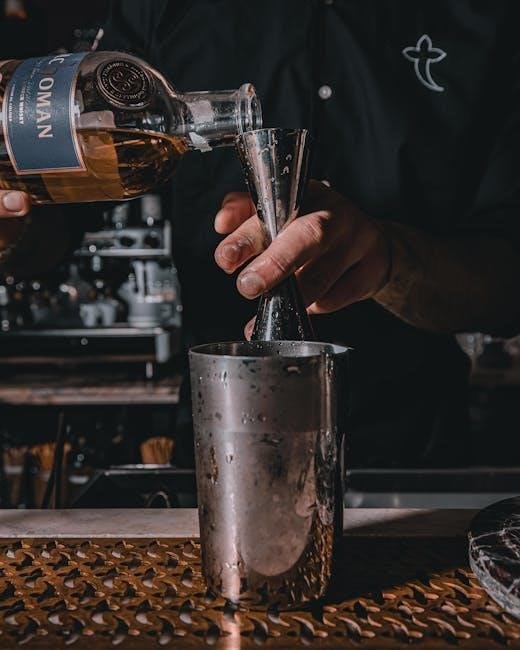
Customer Service and Communication
Effective communication and exceptional customer service are vital for creating a positive experience. Bartenders must be attentive‚ friendly‚ and skilled in conflict resolution to ensure satisfaction and loyalty.
Building Rapport with Customers
Building rapport with customers is essential for creating a welcoming and memorable experience; Bartenders should engage with patrons in a friendly and attentive manner‚ showing genuine interest in their preferences and needs. Active listening and personalized recommendations can foster trust and loyalty. Being approachable and knowledgeable about the menu helps customers feel at ease. Additionally‚ maintaining a positive attitude and handling feedback gracefully strengthens relationships. Regular customers appreciate recognition and tailored interactions‚ which can significantly enhance their satisfaction and encourage repeat visits. By fostering a connection‚ bartenders not only improve customer experiences but also contribute to the establishment’s reputation and success.
Handling Difficult Situations
Handling difficult situations with grace and professionalism is a critical skill for bartenders. Remaining calm and composed when dealing with intoxicated patrons‚ conflicts‚ or dissatisfied customers is essential. Active listening and empathetic communication can de-escalate tensions and resolve issues effectively. Knowing when to involve management or security is also important to ensure safety and compliance. Proper training in conflict resolution and legal compliance‚ such as recognizing fake IDs‚ helps bartenders navigate challenging scenarios confidently. By addressing problems promptly and fairly‚ bartenders can maintain a positive environment and protect both the establishment and its patrons. Effective problem-solving skills are vital for upholding customer satisfaction and operational integrity.
Upselling and Recommending Drinks
Upselling and recommending drinks are essential skills for bartenders to enhance customer satisfaction and increase sales. By understanding customer preferences‚ bartenders can suggest premium spirits‚ specialty cocktails‚ or complementary items like appetizers. Training manuals emphasize techniques like suggestive selling‚ personalized recommendations‚ and highlighting popular or high-margin drinks. These strategies not only boost revenue but also create a memorable experience for patrons. Effective upselling should be subtle and tailored to the customer’s taste‚ ensuring they feel valued rather than pressured. Proper training in this area helps bartenders strike the right balance‚ fostering loyalty and driving business growth through thoughtful and engaging service.
Understanding Customer Preferences
Understanding customer preferences is crucial for delivering exceptional service and creating a positive experience. Bartenders should be adept at identifying what patrons enjoy by observing their behavior‚ asking questions‚ and listening actively. This includes noting favorite spirits‚ flavor profiles‚ and preferences for sweet‚ sour‚ or bitter tastes. Additionally‚ understanding dietary restrictions and allergies is vital to recommend appropriate drinks. Knowledge of popular trends and classic cocktails can also guide recommendations. By tailoring suggestions to individual tastes‚ bartenders build rapport and increase customer satisfaction. Training manuals often emphasize the importance of attentiveness and personalized service to ensure every patron feels valued and well-served‚ fostering loyalty and repeat business;
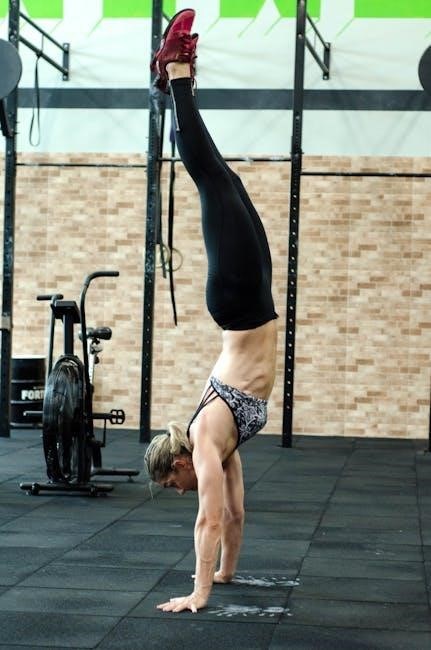
Bar Operations and Management
Effective bar operations involve setting up tools‚ managing inventory‚ and maintaining safety and hygiene; This section covers strategies to optimize efficiency‚ ensure profitability‚ and uphold legal standards.
Setting Up the Bar and Tools
Setting up the bar and tools is crucial for efficient service and a professional appearance. Start with essential equipment like shakers‚ jiggers‚ muddlers‚ and strainers. Ensure all tools are clean and within easy reach. Arrange glassware‚ spirits‚ and mixers in a logical order to streamline drink preparation. Restock supplies like ice‚ garnishes‚ and napkins before each shift. Organize the bar area to minimize movement‚ enhancing speed and accuracy. A well-organized bar not only improves workflow but also elevates the customer experience. Regularly inspect and maintain tools to prevent wear and tear. This setup ensures bartenders can focus on crafting high-quality drinks while maintaining a clean and efficient workspace.
Managing Inventory and Stock
Effective inventory and stock management is vital for maintaining profitability and ensuring seamless bar operations; Start by conducting regular audits to track spirit‚ beer‚ wine‚ and mixer levels. Use inventory management software to monitor stock and identify trends‚ enabling precise reordering. Implement a first-in‚ first-out system to prevent expiration of perishable items. Train staff to accurately count and record stock‚ minimizing discrepancies. Regularly review supplier contracts to negotiate better pricing and delivery terms. Maintain a balanced inventory to avoid overstocking‚ which can lead to waste and increased costs. Proper inventory control ensures that popular items are always available while reducing excess stock‚ ultimately enhancing efficiency and customer satisfaction.
Bar Safety and Hygiene Practices
Maintaining a clean and safe bar environment is crucial for both staff and customers. Regularly sanitize surfaces‚ utensils‚ and equipment to prevent contamination. Ensure proper handwashing techniques are followed by all staff members. Implement a schedule for cleaning and restocking supplies‚ and train employees on waste disposal protocols. Conduct routine checks on equipment to prevent mechanical failures. Establish clear procedures for handling spills and broken glass to avoid accidents. Promote a culture of safety by ensuring all staff are trained in emergency procedures‚ such as fire evacuation and first aid. Proper hygiene and safety practices not only protect health but also enhance the overall customer experience‚ fostering trust and satisfaction.
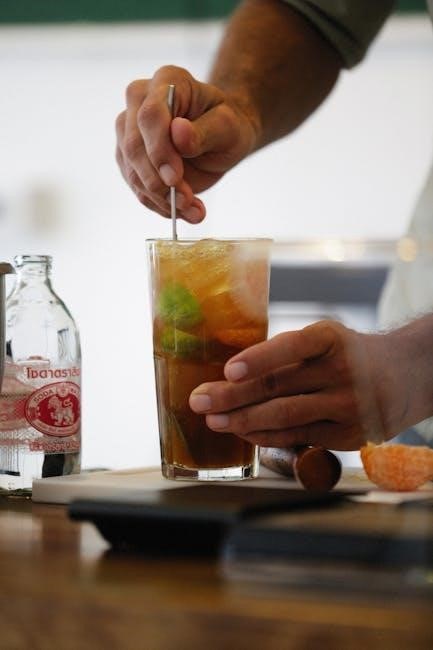
Legal and Compliance Issues
Understanding legal and compliance issues is essential for bartenders to operate responsibly. This includes adhering to age verification laws‚ refusing service to intoxicated patrons‚ and maintaining awareness of local health and safety regulations. Proper documentation and training on legal matters are critical to avoid liability. Ensure compliance with licensing requirements and be familiar with dram shop laws‚ which hold establishments accountable for harm caused by overserving alcohol. Implement protocols for handling fake IDs and refusing service appropriately. Stay informed about updates in alcohol laws and regulations to maintain compliance. Regular training on legal issues ensures bartenders are equipped to handle situations responsibly‚ protecting both the establishment and customers from potential legal consequences.
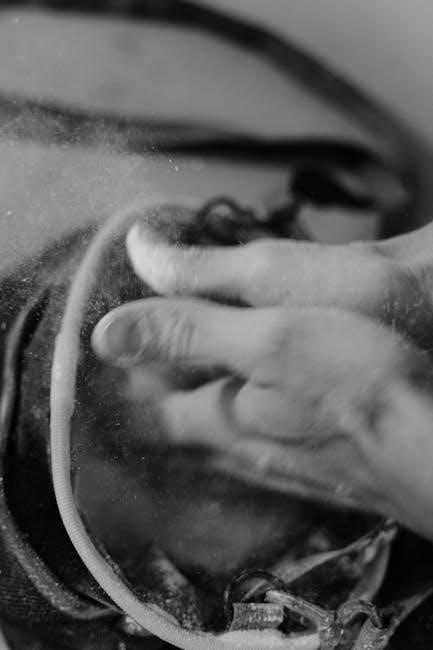
Training and Development
This section focuses on the onboarding process for new bartenders‚ emphasizing hands-on training and mentorship. It also covers ongoing education opportunities to refine skills and stay updated on industry trends‚ ensuring continuous improvement and career growth.
Onboarding Process for New Bartenders
A well-structured onboarding process ensures new bartenders quickly adapt to the bar environment and standards. It begins with an initial orientation‚ introducing the establishment’s culture‚ policies‚ and expectations. This is followed by product knowledge training‚ covering spirits‚ wines‚ mixers‚ and signature cocktails. Hands-on practice behind the bar allows trainees to master drink preparation techniques and familiarize themselves with tools and equipment. Mentorship programs pair new hires with experienced bartenders for guidance and feedback. The process also includes role-playing exercises to improve customer interaction skills and handle challenging situations. Gradual integration into live shifts ensures a smooth transition‚ helping new bartenders build confidence and competence in a supportive environment.
Ongoing Training and Education
Ongoing training and education are crucial for bartenders to stay updated with industry trends and refine their skills. Regular workshops and seminars focus on advanced techniques‚ new cocktail recipes‚ and product knowledge. Many establishments incorporate certification programs to ensure bartenders meet high standards; Continuous learning helps bartenders adapt to changing customer preferences and maintain expertise in mixology. Online courses and resources are often utilized to supplement in-person training‚ allowing bartenders to learn at their own pace. This commitment to education not only enhances individual performance but also fosters a culture of excellence and innovation within the bar team‚ ensuring consistent quality and customer satisfaction. Ongoing training is essential for both personal and professional growth in the bartending profession.
Feedback and Performance Evaluation
Feedback and performance evaluation are essential for fostering growth and maintaining high standards in bartending. Regular performance assessments help identify strengths and areas for improvement‚ ensuring bartenders meet expectations. Managers often use observational techniques and customer feedback to evaluate skills like drink preparation‚ communication‚ and efficiency. Constructive criticism is provided to enhance performance‚ while positive feedback motivates staff to continue excelling.
Tools like checklists and scorecards are commonly used to measure consistency and accuracy. Periodic formal evaluations also track progress over time‚ helping bartenders set goals and develop professionally. This process ensures continuous improvement‚ benefiting both individual growth and the overall success of the bar. Feedback is a cornerstone of professional development in bartending‚ driving excellence and customer satisfaction.
Career Growth and Advancement
Career growth and advancement in bartending require continuous learning and dedication. A well-structured bartender training manual provides clear pathways for progression‚ from entry-level positions to senior roles. It equips bartenders with advanced skills in mixology‚ leadership‚ and customer service‚ enabling them to take on more responsibilities. Many manuals include certification programs and career roadmaps to guide professionals toward specialized roles like head bartender or bar manager. Additionally‚ they offer insights into industry trends‚ entrepreneurship‚ and networking opportunities‚ helping bartenders achieve long-term success. By mastering the content in these manuals‚ bartenders can confidently pursue higher positions and contribute to the growth of their establishments. This resource is invaluable for ambitious individuals seeking to excel in the hospitality industry.
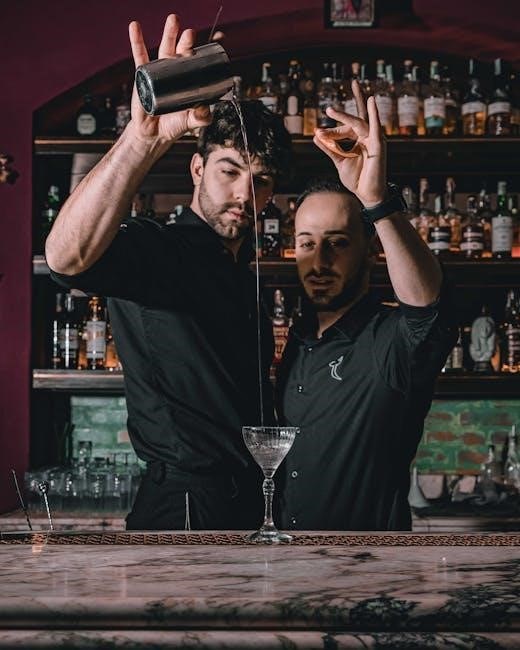
Tools and Resources for Bartenders
This section provides essential tools and resources for bartenders‚ including training manuals‚ guides‚ certification courses‚ and apps for inventory management and cocktail recipes.
Free Bartender Training Manuals and Guides
Accessing high-quality‚ free bartender training manuals and guides is now easier than ever. Many professional platforms offer downloadable resources‚ including comprehensive guides‚ customizable templates‚ and interactive tools. These materials cover essential skills‚ drink recipes‚ and operational best practices‚ providing bartenders with a solid foundation for success. Websites like The Bar Experts offer detailed manuals that include operational tools‚ training guides‚ and customizable templates to suit various bar environments. These resources are designed to enhance both knowledge and practical skills‚ ensuring bartenders can deliver exceptional service and create outstanding cocktails. Whether you’re a novice or an experienced professional‚ these free resources are invaluable for continuous learning and career growth in the bartending industry.
Recommended Books and References
For in-depth knowledge‚ The Bar Starts Here by Ryan Dahlstrom is a highly recommended resource. This comprehensive guide‚ often referred to as the “Holy Grail Book of Business for Bars‚” offers over 500 pages of operational tools‚ training manuals‚ and customizable templates. Designed for bar owners‚ employees‚ and enthusiasts‚ it provides practical insights into bartending‚ marketing‚ and bar management. The book also includes downloadable materials‚ making it a versatile and valuable tool for both beginners and experienced professionals. As a Certified Consulting Bar Expert‚ Dahlstrom’s expertise ensures the content is both authoritative and actionable‚ making it an essential addition to any bartender’s library.
Online Courses and Certification
Enhance your bartending skills with online courses and certifications designed to elevate your expertise. Platforms like The Bar Experts offer comprehensive training programs‚ including downloadable materials and interactive guides. These courses cover essential topics such as cocktail recipes‚ drink preparation‚ and customer service. Many programs are customizable‚ allowing you to learn at your own pace and focus on areas that need improvement. Certification upon completion not only boosts your credibility but also demonstrates your commitment to professional growth. Whether you’re a novice or an experienced bartender‚ these resources provide the tools and knowledge needed to excel in the industry and stay updated on the latest trends and techniques.
Apps and Software for Bartenders
Modern bartenders can leverage a variety of apps and software to enhance their skills and streamline operations. Tools like BinWise offer inventory management solutions‚ helping track stock levels and optimize ordering. Cocktail recipe apps provide instant access to classic and modern drink formulas‚ ensuring consistency. Additionally‚ apps like Flaviar and Distiller focus on spirit and cocktail education‚ offering in-depth knowledge for product pairing and customer recommendations. Many platforms also include training modules and certification programs‚ allowing bartenders to improve their expertise. These digital resources are invaluable for both new and experienced bartenders‚ helping them stay organized‚ informed‚ and efficient behind the bar.

Appendices and Additional Resources
This section provides checklists‚ glossaries‚ and further reading materials‚ along with additional resources and tools for ongoing bartender education and professional skill enhancement.
Glossary of Bartending Terms
This section provides a comprehensive list of key bartending terms and their definitions‚ ensuring a solid understanding of industry-specific language. From basic techniques like shaking and stirring to advanced concepts like muddling and garnishing‚ this glossary covers essential vocabulary. Terms such as sour‚ daiquiri‚ and mojito are explained‚ along with tools like jiggers and muddlers. Understanding these terms is crucial for effective communication and mastery of cocktail preparation. This resource is designed to help new bartenders build a strong foundation and veterans refine their knowledge of the craft.
Common Cocktail Mistakes to Avoid
Perfecting cocktail preparation requires attention to detail and avoiding common pitfalls. Over-shaking or under-shaking can alter the balance of flavors‚ while using incorrect glassware may affect presentation. Neglecting to measure ingredients accurately can lead to inconsistent tastes‚ and improper garnishing can detract from the drink’s appeal. Additionally‚ using low-quality spirits or mixers can compromise the final product. Another mistake is not chilling glasses before serving‚ which can dilute the drink. Lastly‚ poor time management during preparation can slow service. By addressing these errors‚ bartenders can ensure high-quality‚ visually appealing cocktails that meet customer expectations and maintain professional standards.
Checklists for Bar Setup and Closure
Efficient bar setup and closure are crucial for smooth operations. A pre-shift checklist ensures everything is ready: turn on lights and music‚ arrange tools‚ restock supplies‚ and chill glasses. Post-shift‚ clean and sanitize equipment‚ wipe down surfaces‚ count inventory‚ and secure alcohol. Properly managing cash handling and locking up are also essential. These checklists help maintain organization‚ reduce waste‚ and ensure compliance with safety standards. By following these routines‚ bartenders can start and end shifts confidently‚ knowing the bar is prepared for the next day. Consistency in these tasks contributes to a professional and efficient bar environment.
Further Reading and References
For deeper insights and advanced techniques‚ explore resources like The Bar Starts Here by Ryan Dahlstrom‚ offering over 500 pages of operational tools and training guides. The Bar Experts provides downloadable manuals and courses to enhance skills. Additionally‚ platforms like BinWise offer drink guides and inventory management tips. Online courses and certification programs are available through hospitality training websites. These resources cover topics from cocktail creation to bar management‚ ensuring a well-rounded education. They are essential for bartenders aiming to advance their careers and stay updated on industry trends. Utilize these materials to refine your expertise and maintain high standards in your professional journey.

